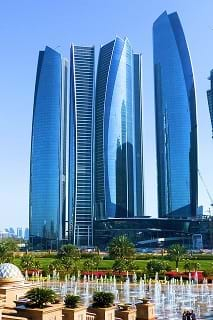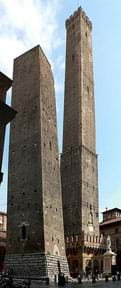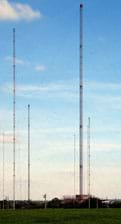Quick Look
Grade Level: 7 (6-8)
Time Required: 1 hour
Expendable Cost/Group: US $1.75
Group Size: 4
Activity Dependency: None
Associated Informal Learning Activity: Build a Tower with an Egg on Top
Subject Areas: Science and Technology
NGSS Performance Expectations:

| MS-ETS1-1 |
| MS-ETS1-2 |
Summary
Towers have been a part of developed society for centuries, serving a variety of purposes, from watch towers to modern cell towers. In this activity, student groups design and build three types of towers (guyed or cable-supported, free-standing or self-standing, and monopole), engineering them to meet the requirements that they hold an egg one foot high for 15 seconds.
Engineering Connection
Engineering designs are subject to requirements and constraints, often including limitations on time, materials and budget, and specifications for size, strength, materials, capacity, etc. Engineers design different types of towers to best suit different purposes.
Learning Objectives
- Follow the steps of the engineering design process to create an egg holder at the top of tower.
- Parts of a structure.
- Types of towers and comparisons.
- Safe use of tools and machines.
- Forces that must be taken into consideration when building structures.
Educational Standards
Each TeachEngineering lesson or activity is correlated to one or more K-12 science,
technology, engineering or math (STEM) educational standards.
All 100,000+ K-12 STEM standards covered in TeachEngineering are collected, maintained and packaged by the Achievement Standards Network (ASN),
a project of D2L (www.achievementstandards.org).
In the ASN, standards are hierarchically structured: first by source; e.g., by state; within source by type; e.g., science or mathematics;
within type by subtype, then by grade, etc.
Each TeachEngineering lesson or activity is correlated to one or more K-12 science, technology, engineering or math (STEM) educational standards.
All 100,000+ K-12 STEM standards covered in TeachEngineering are collected, maintained and packaged by the Achievement Standards Network (ASN), a project of D2L (www.achievementstandards.org).
In the ASN, standards are hierarchically structured: first by source; e.g., by state; within source by type; e.g., science or mathematics; within type by subtype, then by grade, etc.
NGSS: Next Generation Science Standards - Science
| NGSS Performance Expectation | ||
|---|---|---|
|
MS-ETS1-1. Define the criteria and constraints of a design problem with sufficient precision to ensure a successful solution, taking into account relevant scientific principles and potential impacts on people and the natural environment that may limit possible solutions. (Grades 6 - 8) Do you agree with this alignment? |
||
| Click to view other curriculum aligned to this Performance Expectation | ||
| This activity focuses on the following Three Dimensional Learning aspects of NGSS: | ||
| Science & Engineering Practices | Disciplinary Core Ideas | Crosscutting Concepts |
| Define a design problem that can be solved through the development of an object, tool, process or system and includes multiple criteria and constraints, including scientific knowledge that may limit possible solutions. Alignment agreement: | The more precisely a design task's criteria and constraints can be defined, the more likely it is that the designed solution will be successful. Specification of constraints includes consideration of scientific principles and other relevant knowledge that is likely to limit possible solutions. Alignment agreement: | All human activity draws on natural resources and has both short and long-term consequences, positive as well as negative, for the health of people and the natural environment. Alignment agreement: The uses of technologies and any limitations on their use are driven by individual or societal needs, desires, and values; by the findings of scientific research; and by differences in such factors as climate, natural resources, and economic conditions.Alignment agreement: |
| NGSS Performance Expectation | ||
|---|---|---|
|
MS-ETS1-2. Evaluate competing design solutions using a systematic process to determine how well they meet the criteria and constraints of the problem. (Grades 6 - 8) Do you agree with this alignment? |
||
| Click to view other curriculum aligned to this Performance Expectation | ||
| This activity focuses on the following Three Dimensional Learning aspects of NGSS: | ||
| Science & Engineering Practices | Disciplinary Core Ideas | Crosscutting Concepts |
| Evaluate competing design solutions based on jointly developed and agreed-upon design criteria. Alignment agreement: | There are systematic processes for evaluating solutions with respect to how well they meet the criteria and constraints of a problem. Alignment agreement: | |
International Technology and Engineering Educators Association - Technology
-
Evaluate designs based on criteria, constraints, and standards.
(Grades
3 -
5)
More Details
Do you agree with this alignment?
-
There is no perfect design.
(Grades
6 -
8)
More Details
Do you agree with this alignment?
-
Requirements for design are made up of criteria and constraints.
(Grades
6 -
8)
More Details
Do you agree with this alignment?
-
Design involves a set of steps, which can be performed in different sequences and repeated as needed.
(Grades
6 -
8)
More Details
Do you agree with this alignment?
-
Make two-dimensional and three-dimensional representations of the designed solution.
(Grades
6 -
8)
More Details
Do you agree with this alignment?
-
The selection of designs for structures is based on factors such as building laws and codes, style, convenience, cost, climate, and function.
(Grades
6 -
8)
More Details
Do you agree with this alignment?
-
Apply the technology and engineering design process.
(Grades
6 -
8)
More Details
Do you agree with this alignment?
-
Refine design solutions to address criteria and constraints.
(Grades
6 -
8)
More Details
Do you agree with this alignment?
-
Develop innovative products and systems that solve problems and extend capabilities based on individual or collective needs and wants.
(Grades
6 -
8)
More Details
Do you agree with this alignment?
-
Create solutions to problems by identifying and applying human factors in design.
(Grades
6 -
8)
More Details
Do you agree with this alignment?
-
Document trade-offs in the technology and engineering design process to produce the optimal design.
(Grades
9 -
12)
More Details
Do you agree with this alignment?
State Standards
Massachusetts - Science
-
Identify and explain the steps of the engineering design process, i.e., identify the need or problem, research the problem, develop possible solutions, select the best possible solution(s), construct a prototype, test and evaluate, communicate the solution(s), and redesign.
(Grades
6 -
8)
More Details
Do you agree with this alignment?
-
Identify appropriate materials, tools, and machines needed to construct a prototype of a given engineering design.
(Grades
6 -
8)
More Details
Do you agree with this alignment?
-
Explain how such design features as size, shape, weight, function, and cost limitations would affect the construction of a given prototype.
(Grades
6 -
8)
More Details
Do you agree with this alignment?
-
Describe and explain parts of a structure, e.g., foundation, flooring, decking, wall, roofing systems.
(Grades
6 -
8)
More Details
Do you agree with this alignment?
Materials List
- photographs and drawings of example towers, and/or Internet URLs for tower information (see suggestions under the References section)
- cardboard tubes and sheet material (purchase cardboard sheets from local paper suppliers or ask for donations from local printers or find from recycling bins; provide an allotted amount to each team for each tower problem)
- other classroom building materials and tools, such as scissors, tape, hot glue, paper, straws, string, etc.
- Note: If available, build sturdier towers using small wooden dowels and plastic tubing, which enables students to gain experience with hand and power tools.
- Activity Worksheet
Worksheets and Attachments
Visit [www.teachengineering.org/activities/view/tower_investigation] to print or download.Introduction/Motivation

Towers have been a part of developed society for centuries. Towers serve a variety of purposes. What towers can you think of in your community? What are they used for? What other types of towers can you think of? (Listen to student suggestions and descriptions of their purposes. Examples: fire look-out towers, observation tower, watch tower, prison tower, silo, light house, bell tower, clock tower, minaret, church spire, water tower, oil drilling tower, turret, chimney, skyscraper, rotating restaurant tower, bridge tower [for cable-stayed and suspension bridges], airport control tower, wind turbine tower, radio mast, radar tower, antenna tower, electrical transmission tower, cellular communication tower. How are these towers similar? (Towers are all structures that are taller than they are wide.) How are they different or unique from each other in their designs? (Some are self-supporting and others require external support via wires and cables. This will be researched more in the activity.)
Engineering designs (including the design of towers) are subject to requirements and constraints. Can you think of any examples of what these might be? (Listen to student ideas. Examples: time, funding, materials, expected loads, and functionality specifications such as size, height, etc.)
Today, your team is going to design, construct and test three types of model towers Just like all engineering projects, it will have some requirements and constraints: Your towers must hold an egg one foot high for 15 seconds.
Who remembers the steps of the engineering design process? (Listen to student suggestions. Write on the board: ask to identify the need or problem, research the problem, imagine possible solutions, plan by select the best solution, create a prototype, test and evaluate, improve and redesign.) Through these steps, we'll come up with good solutions.

Let's get started!
Procedure
Background

The engineering design process has the following steps:
- Ask to identify the need or problem.
- Research the problem.
- Imagine possible solutions (brainstorm!).
- Plan by select the best possible solution(s).
- Create a prototype.
- Test and evaluate.
- Redesign (and improve!).
Three tower types: Towers are usually classified into three categories: guyed or cable-supported, free-standing or self-standing, and monopole. The self-supporting and monopole towers are similar in that neither requires guy wires or any other support structure. Guyed type towers are usually the least expensive.
As a general rule, three main specifications are needed to choose a tower site: site selection, tower type and tower specification knowledge (or tower code) within the community.
For reference, see Douglas Prime's six-page Fairly Fundamental Facts about Forces & Structures: Word doc version or pdf version
Before the Activity
- Gather materials.
- Make copies of the Activity Worksheet, which includes student instructions.
- Find websites; make copies of tower drawings and diagrams, if desired.
With the Students
- Introduce the topic of towers. Facilitate a discussion on different types of towers and their uses. Talk about the design process, including a discussion on the benefits of sketches, multiview drawings, and orthographic projections.
- Organize students into small groups. Hand out the worksheets.
- Explain criteria for the tower design and construction. Each group must design and create one of each of the following: a guyed tower (cable supported), a self-standing tower, and a monopole tower. Each tower must be able to support the weight of an egg for 15 seconds.
- Students test and measure the three types of towers by evaluating height, strength (ability to hold an egg), and the amount of material usage.
- Students participate in the presentation of the group solutions to the class.
- Students present comparisons or advantages and disadvantages of the different tower types.
Assessment
Project & Presentation Evaluation: As student teams present to the class their three tower designs, results and conclusions, grade their accomplishments using the attached Rubric for Performance Assessment, which includes criteria for design, construction and presentation.
Investigating Questions
- What is the purpose of towers?
- Why is one type of tower preferable to another?
- How can an egg be held and supported at the top of a tower?
- How can we build models to represent the three recognized types of towers?
- What is meant by tension, compression, torsion and shear in construction?
- What are the parts of this structure (tower) that are similar to those found in bridge design?
Subscribe
Get the inside scoop on all things TeachEngineering such as new site features, curriculum updates, video releases, and more by signing up for our newsletter!More Curriculum Like This

Students are presented with a brief history of bridges as they learn about the three main bridge types: beam, arch and suspension. They are introduced to two natural forces — tension and compression — common to all bridges and structures.

Students design, build and test towers made of craft sticks and/or dowels.
References
Sturdivant, Peter. So You Want to Build a Tower? Published August 1998. Wireless Network Systems. Accessed August 9, 2001. http://www.angelfire.com/me/blkstrpra/aug98.html
Tower Photographs. Pre-Engineering Software Corp. Accessed August 9, 2001. http://www.pre-engineering.com/resources/towers.htm
Copyright
© 2013 by Regents of the University of Colorado; original © 2005 Worcester Polytechnic InstituteSupporting Program
Center for Engineering Educational Outreach, Tufts UniversityLast modified: July 23, 2020








User Comments & Tips